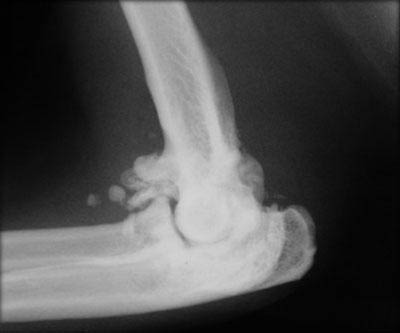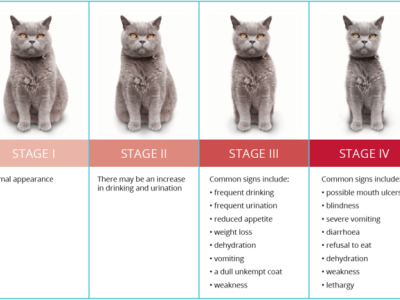Feline Osteoarthritis
Arthritis is a complex disease involving the painful inflammation and degeneration of joints. As the joint cartilage (the spongy cushion layer in the joint) begins to thin, this causes pain and the release of inflammatory cells. These cells produce molecules that cause further damage to the joint and start a vicious cycle of damage =>inflammation => further damage.
There are many and varied causes of arthritis including congenital abnormalities, abnormal pressure on the joint, trauma, infection or old age degeneration. Cats are notorious for hiding signs of pain and arthritis often goes unnoticed as a result or is put down to them “just getting old”.
What to look for at home?
- Less inclined to jump up as high as they used to. E.g. using a chair to get on a table, rather than jumping directly to the table.
- Hesitant to jump off tables or high places - Spend less time playing and more time sleeping
- Hesitant to climb stairs
- Reduced grooming
- Signs of pain or “being grumpy” when picked up or handled along their back.
- Limping in severe cases.
If you are concerned about any of these changes please contact the clinic.

What can your vet do to diagnose arthritis?
We can confirm the presence of arthritis by performing radiographs. Regular preventative health checks to monitor for any signs of pain and starting treatment to stop the pain of arthritis and reduce the progression of this debilitating disease.
What can we do to manage arthritis?
Arthritis is a manageable disease with a variety of modalities.
1. Pain relief such as non-steroidal anti-inflammatories (metacam), or tramadol +/- gabapentin. These medications provide active pain relief, but do not stop the progression of the arthritis. For long term use of these medications we recommend annual blood tests and at least 6 monthly revisits to ensure that the medication is still working appropriately and is not having any undesirable side effects, particularly on kidney function.
2. Disease modifying osteoarthritis drugs (DMOADs) such as zydax injections. Zydax is not currently registered for use in cats, however it is commonly used off label in cats with arthritis to help slow the progression of the disease and provide pain relief. It is a joint modifying drug that reduces inflammation and slows cartilage degeneration by blocking the production of enzymes that breakdown cartilage. It is given as a course of once weekly injections, for 4 weeks, at least every 6 months. Some cats will require these injections more frequently and we can tailor the course to fit your cat’s individual requirements.
3. Joint specific diets such as Hill’s J/D These diets provide the right blend of fatty acids, glucosamine, chondroitin and other essential nutrients for optimal joint health. This can help slow joint damage and improve overall function. Speak to your vet to see if this is the right diet for your cat.
4. Nutriceutical additives such as glucosamine and condroitin. These supplement help to improve cartilage function by holding water into the cartilage making it spongier and better able to withstand the normal pressures of movement. This helps reduce pain and slow the progression of arthritis.
5. Green-lipped mussel extract.
This is a naturally found anti-inflammatory that doesn’t have the side effects on kidney function that we commonly see with NSAID use. It is a fishy smelling powder that can also act as an appetite stimulant. PAWs osteosupport and GLYDE powder both contain high levels of this and are an excellent supplement that can be easily sprinkled over food.
6. Weight loss
By reducing your cat’s weight to within the normal (or ideally the low normal) weight range means that there is less weight on the individual joints and thus less pressure when they are already inflamed. This will help reduce pain and also slow arthritis progression.
7. Acupuncture and massage
Acupuncture and massage in conjunction with other conventional treatments can be an effective way to reduce pain in cats with arthritis. For more information, please speak to your vet.
8. Surgery
In some cases of severe arthritis surgery may be recommended to reduce pain or even replace whole joints (such as a total hip replacement). Your vet can discuss if this is something your cat would benefit from.
What can you do at home to prevent arthritis?
1. Maintain a healthy weight. Obesity adds extra pressure to joints, exacerbating pain and speeding the progression of arthritis. It also increases the risk of developing diabetes, urinary tract disease and heart problems. To check if your cat is a healthy weight, just ask you vet at your next preventative healthy check. If they are overweight, starting a strict weight loss diet such as Royal Canin obesity, Eukanuba weight control or hills r/d and feeding for the weight that they should be is a great start to their weight loss program. Splitting the food into a morning and evening meal, and preventing grazing by removing food if it hasn’t been eaten within 15 minutes can also help reduce weight.
2. Start on a senior/joint specific diet or add supplements such as glucosamine, condroitin and green lipped mussel extract to the diet.
3. Encourage regular exercise. Whether it be taking them for a walk or encouraging low grade play activities
4. Monitor for changes in behaviour that could indicate discomfort and contact your vet for a full examination and further work up if required.
5. Make your house arthritis-friendly. Ramps to and from their favourite spots, easy access litter trays with lower edges, multiple feeding/water stations and litter trays within easy reach of common resting sites and a soft, comfortable, warm area for resting/sleeping.
If you have any further questions or concerns, please do not hesitate to contact the clinic.![]() Feline Osteoarthritis PDF135.33 KB
Feline Osteoarthritis PDF135.33 KB

